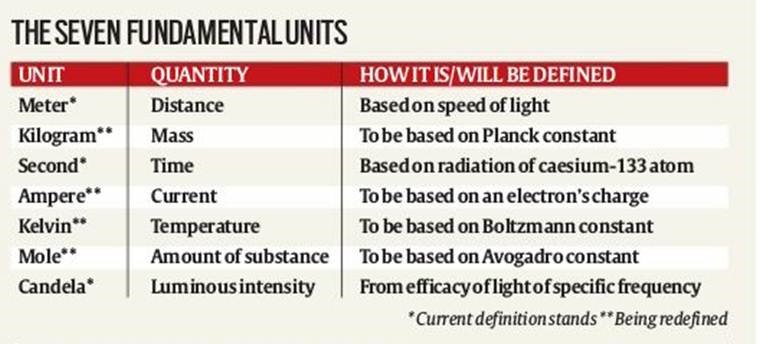Why in news?
The Definition of the Kilogram is about to change by redefining the International system of units(SI).
How does the measurement of kilogram evolve?
- There are seven fundamental units and every other unit of measurement can be derived from one or more of these seven units.

- Three of the seven fundamental units are already based on unchanging properties of nature.
- These are the second (time), the metre (distance), and the candela (luminous intensity, a measure for light’s brightness).
- Hence, scientists want to create a measurement system that is based entirely on unchanging fundamental properties of nature.
- The first kilogram (originally called a grave) was defined in 1793 by a commission of the French Academy of Sciences, who wanted a better standard than the fixed amounts of grain that had traditionally been used.
- The commission decided that the new measure would be the mass of one cubic decimetre of distilled water at 4 degree celcius (the temperature at which water has its highest density under standard conditions).
- This had the advantage in that most properly equipped labs would be able to reproduce this standard.
- Subsequently, a prototype of this mass was cast in brass.
- Unfortunately, this definition/calculation of mass depended upon another variable measurement, the metre.
- At this point, the metre was only provisionally defined as part of the distance from the North Pole to the equator.
- However, once the value of the metre and the temperature of water at its densest were more accurately defined, a new prototype was cast in platinum to represent this mass(kilogram).
- These variable measurements were finally replaced with the international prototype kilogram (IKP), used today, which is a metal cast from a mixture of platinum and iridium to make it very hard and prevent it reacting with oxygen.
- Since 1889, countries who are members of the General Conference on Weights and Measures have agreed to use this standard block of metal kept near Paris to define the kilogram.
- This made the kilogram to be the only base unit in the SI still defined by a physical object.
- Six Copies of the IKP are transported across the world to ensure all participating countries use the same standard.
- But although this metal is stored in a highly controlled environment, its weight can change by tiny amounts as wear and tear causes it to lose mass and dirt causes it to increase.
- Hence, even the modern IPK to measure the kilogram can gradually change in mass.
What is the proposed measure?
- To address this problem, scientists around the world have spent nearly two decades discussing how the kilogram could instead be defined in relation to constant measurements of nature.
- So they decided that instead of measuring the kilogram against a block stored in a vault, it should be based on precise values of constants of nature.
- Thus the kilogram’s definition is set to change and the new definition of the kilogram uses a measurement from another fixed value from nature, Planck’s constant (h).
- Planck’s constant will be defined as 6.62607015×10−34 joule seconds and can be found by dividing the electromagnetic frequency of a particle of light or “photon” by the amount of energy it carries.
- The constant is usually measured in joule seconds but this can also be expressed as kilogram square metres per second.
- Since 1967, the second has been defined as the time it takes for a certain amount of energy to be released as radiation from atoms of Caesium-133.
- This became the basis of all measures of time, and is used in atomic clocks.
- The SI unit of the metre is also based on another universal constant, namely the speed of light.
- The metre is defined as the distance travelled by light in vacuum in 1/299,792,458 of a second (which is already defined).
- Thus, since definition of a second and a metre have already adjusted to universal constants, by adding these measurements, along with an exact knowledge of Planck’s constant, a very precise definition of the kilogram can be reached easily.
Does this redefining really help science?
- The change in definition of the second, previously, has helped ease communication across the world via technologies like GPS and the Internet.
- In the same way, the change in the kilogram will be better for technology, retail and health.
- For most people, everyday life will carry on as normal despite the redefinitions.
- One standard bag of sugar will contain as much sugar as it ever did.
- But some of these changes will mean practical advantages for scientists making very precise measurements.
- Thus, to answer the question how much is a kilogram, we will no longer have to compare blocks of platinum or worry about scratching them.
Source: The Indian Express, The Wire
